Dancing with Bees: A Journey Back to Nature
Air Date: Week of July 3, 2020
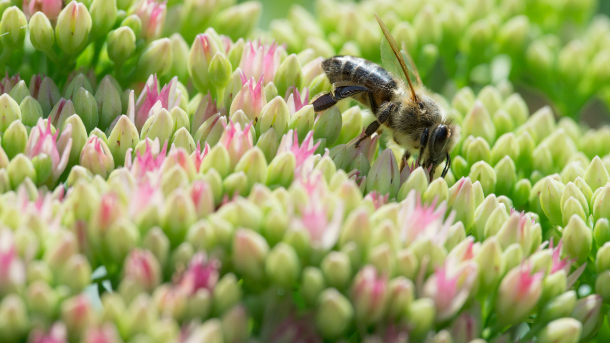
The United States has over 4,000 species of native bees, the majority of which are solitary bees. (Photo: Jonas Rösing, Flickr, CC BY-SA 2.0)
The innate curiosity about and connection to the natural world that many of us experience as children are often lost on the path to adulthood. Brigit Strawbridge Howard, author of Dancing with Bees: a Journey Back to Nature, found her way back to a childlike fascination with nature with the help of some of the world's most important pollinators: honeybees, bumblebees, and oft-overlooked solitary bees. Brigit joins Host Bobby Bascomb to discuss the fascinating habits of solitary bees, how to help diverse bee species thrive in your own backyard, and how best to reconnect with nature.
Transcript
BASCOMB: It’s Living on Earth, I’m Bobby Bascomb. As children, most of us are innately curious about the natural world. But on the way to adulthood that curiosity and connection are often lost. When author Brigit Strawbridge Howard realized she wanted to recapture her childhood connection to nature she chose the humble bee as ambassador to the world she wanted to explore. In her book Dancing with Bees: a Journey Back to Nature, Brigit describes how she learned to notice the world around her by paying special attention to the honeybees, the bumblebees, and solitary bees that buzzed right through her garden and into her heart. And she joins me now. Brigit – welcome to Living on Earth!
HOWARD: Thank you. Thank you so much for inviting me.
BASCOMB: In your journey to learn about bees, you learned a lot. I mean, there are thousands of different species of bees, as you mentioned, and many of us probably just think of honey bees, maybe bumble bees, but how many species are there and, and what you know, really sets them apart from each other?
HOWARD: Okay, well on planet Earth, there are some 20,000 to 25,000 different species. And those are just the ones that have been recorded, you know, and described, and I think you have about 4,000 species in North America alone. And I think about nine of those are honeybees. Plus there are some subspecies and there are around 250 different species of bumblebee and the rest are solitary bees. Broadly speaking, you can divide these bees between those that are social, truly social, that's the honeybees and the bumblebees, and those that are not fully social. Some of them have social traits, but some of them are like single mums. Social insects have a queen. And they have sometimes tens of thousands of workers in a colony and they have males. And there is a division of labor. But there's also cooperative care of the young. So that doesn't happen with solitary bees. And the majority of the bees on this planet are solitary. And it's only the honeybees that make honey, hence the name honeybees. I think that's, that's one of the first things. Bumblebees collect nectar and store nectar to feed their young, but they're not alchemists like honeybees, they don't turn it into honey. And it's the solitary bees that I have found most fascinating, more because of their nesting behavior than anything else.
BASCOMB: Well, how do they nest that sets them apart?
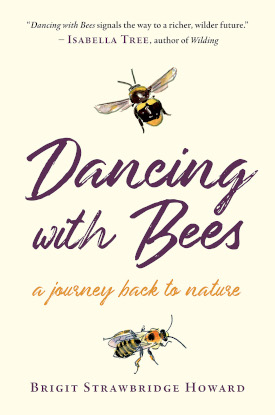
Dancing with Bees: A Journey Back to Nature is about naturalist Brigit Strawbridge Howard’s desire to recapture the connection with the natural world that she felt as a child. (Photo: Courtesy of Chelsea Green Publishing)
HOWARD: All of the solitary bees that that live in readymade cavities, and they could be cavities in a wall or they could be manmade nesting tubes made out of cardboard tubes or bamboo or something like that. The thing about these cavity nesting solitary bees, all of the mason bees and all of the leaf cutters as well, is that they are opportunists. So they take advantage of existing empty cavities. And the mason bees the way that their life cycle goes is so simple, really, they...I'm watching them out in our front garden at the moment. Once they've mated, the males have absolutely nothing to do then with the rearing of the brood. And then each individual female sets about searching for a place to lay her eggs in. And she's probably got about, say 20 or 30 eggs to lay in her short life on the wing. And so suppose you've got a bee hotel, bee nesting box in your back garden, and she chooses one of your bamboo tubes. First thing she'll do is she blocks off the back with a little bit of mud, which she's mined. That's why she's called a mason bee. And then she goes backwards and forwards, backwards and forwards collecting pollen. This bee incidentally, doesn't collect her pollen in pollen baskets, like the social bees. The bumblebees and honeybees have great big baskets to collect pollen. She collects them underneath her abdomen on little stiff, branched hairs. So she takes all of this pollen back in and she drops it in the back of the nesting tube. And when she's collected sufficient of this pollen, she taps it all into place. And then she lays an egg on top of the pollen. When she's laid that egg, she then collects more mud and she blocks that little cell off. And then more pollen, another egg and another bit of mud. And she'll go all the way to the entrance of the tube. And when she gets to the very edge of the tube, she blocks it off with a big plug of mud to seal the tube so that the whole tube is sealed. And the other thing she does, which is incredibly clever, is she lays female eggs at back and male eggs at the front. And this is because these often are predated, these nests, by birds. And it is better for the species that it's the males that are predated than the females. So they're all, they're all so, so different. Once you make the time to sit and watch them, if you have the time which of course we do have at the moment, it's just lovely to watch them and mind boggling to think what they get up to.
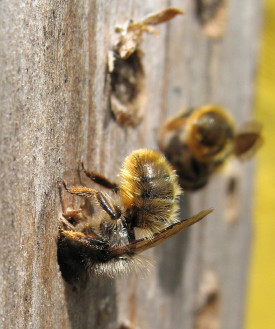
Two red mason bees work to seal up their nests. (Photo: Nigel Jones, Flickr, CC BY-NC-ND 2.0)
BASCOMB: Well, we've heard that insects have all kinds of are in really sharp decline in populations, including bees. How bad is the population collapse for bees specifically? And why is that?
HOWARD: So, some of the most endangered, the rarest bees, it's become very clear that it's habitat loss that is the prime, the main driver. Pesticides, and by pesticides, I mean, insecticides, herbicides, fungicides, molluscicides, you know, the whole gamut of "-cides". Climate change is massive. And, you know, 10 years ago, I hadn't quite realized how big an issue climate change was. There's pathogens, and parasites, diseases, invasive species, poor husbandry, so you know, the way that we look after them or don't look after them is also a contributing factor.
BASCOMB: Yeah, I mean, there's a lot there that you just said. I mean, with climate change alone, I would imagine you know, some plants are flowering earlier than they used to. And the bees, maybe they don't coincide with that and they miss their meal and can't lay their eggs and that's that or maybe it's too hot for them, too cold for them. I mean, it's so very complicated.
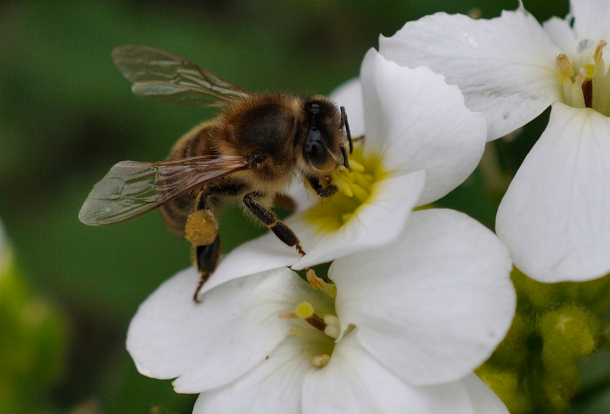
One of the consequences of climate change is altered flowering times for certain plants, leading to a mismatch in timing with insects coming out of hibernation. (Photo: m.shattock, Flickr, CC BY-SA 2.0)
HOWARD: It is everything you just said. What's obvious to us is if it's flooding. If it's flooding, then bumblebee nests are going to flood. And if there's a drought, the plants are going to wither and die, or the nectar is gonna dry up and there's not going to be enough for the bees to feed. If the weather is terrible, they're not gonna come out. So those are the obvious effects of climate change. But you also mentioned plants flowering at different times, to the pollinating insects, that that pollinate them. And that's happening a lot. And one of the reasons that that is happening, I only really am able to tell you about Europe and the United Kingdom. So, as the weather gets warmer in the south of England, we start to have lots of our insects coming out of hibernation a lot earlier than they used to. So in February, instead of April. But plants tend, as well as taking their cue from the warmth and the weather, they also take their cue from daylight hours. So, whilst the weather is now warmer in February than it used to be, the daylight hours are no longer than they used to be. So that means, you know, it's it's very often it's the insects emerging before the flowers.
BASCOMB: Well, what can the average person do to help bees and other pollinators for that matter?
HOWARD: We can do so much and this is the beauty of trying to help bees. It's not like trying to to save, you know, one of our our huge, great, big, wonderful carnivores, everybody can do something to help bees. So for starters, if you have access to growing space, you know a back garden, a backyard, or a larger piece of land, then we can grow a larger variety of plants that are rich in pollen and nectar than we already do. So whatever you do, you know, plant more. And with these 20,000, 25,000 different species of bee, clearly it's not a case of one plant suits all bees, or one bee pollinates all plants. So we need to increase diversity. We need flowers of different sizes as well. Flowers for a long-tongued bees and short-tongued bees. Flowers with flatheads, flowers with bells, tubes, cups, huge, huge variety of flower shapes. So that's important. Stop using pesticides, find alternatives. And once you stop using the insecticide, you know, a whole host of beneficial insects move in and they take care of the pests for you so that's another thing. And the other thing I always think is one of the most beautiful things we can do, and maybe this is where I would start, is get out in your backyard, or your garden, or your plot and look. And notice, and watch, and observe, and get to know the insects that you already have there. It'll be really obvious to you if you have a plant that nobody visits, you know, if there's no interest in one plant, but another is just covered in insects throughout the day, then maybe plant more of the one that's covered in insects. And I also think if you start to take time to watch, it's very difficult not to start falling in love with them. And then when that happens, you start to look more deeply into causes of their decline. And you tend to want to do more to help them anyway then. So I think that's important. And providing habitat, allowing some of your growing space to be messier. You know, be a lazy gardener and allow some of your plot to re-wild.
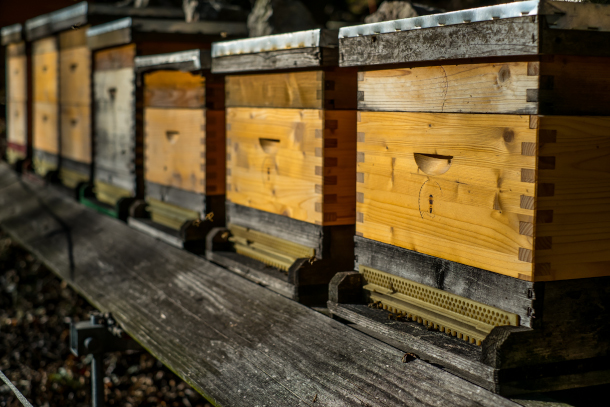
Many think that beekeeping is the best way to save bees, but this simply puts a hive of honeybees, who are not considered endangered, into one’s care. Instead, Brigit recommends planting a variety of flowers and moving away from insecticides as the best steps to protect these pollinators. (Photo: Franz Jachim, Flickr, CC BY-NC-ND 2.0)
BASCOMB: You know, I have to tell you, since I've been reading your book, I notice bees more. You know, I think I feel curious. You know, what is this bee and what's it doing, what's it's activities? Is it making a nest in the leaves or is it just poking around in there? You know, it's so fascinating once you start to look how much more you see. And then you realize how little you really know.
HOWARD: Oh, I know. That's music to my ears. Do you know what, when I stopped relying on learning about bees from books, and started just watching them myself, and imagined what's it doing under that pile of leaves. And if it's a huge bumblebee, and you keep watching, and it gets up and it flies away, and it doesn't come back, you think, oh, well, it was just investigating. But if you sit long enough, and it comes back, then you think oh my gosh, it could be nesting there. And you only notice it if you give it the time of day, if you sit and really, really watch. I start to recognize the different sounds as well, that different bees make, you know, the huge great big bumblebees, the bigger they are, the deeper their buzzing. [LOW PITCHED BUZZ] And then sometimes you just get used to that noise and you hear [MEDIUM PITCHED BUZZ]. And you think, oh, that's not a bumblebee and you then go searching for that bee. And one of the most exciting connections I made of all was hearing another buzz, a very, very weird buzz. And it was kind of like a dentist drilling. I was sitting in my garden listening to bees and I heard [THREE HIGH PITCHED BUZZES] and I thought, oh, that sounds like a bee that's maybe stuck in a spider's web or something. It sounds really alarmed. And I followed the sound of the buzz, and I found this bee inside a poppy and she was going round and round and round inside the poppy, having a pollen bath. And so I listened and watched and in time I realized that the bees, when they came to the poppies always made that noise. When I looked it up to see, you know, what's going on here. It turned out that those bees were buzz foraging or sonicating. And it's really only bumblebees, and some of the solitary bees that can do this. Bumblebees, what they do is they come and they wrap themselves around the flower, and then they disconnect the flight muscles inside their thorax, but they continue to vibrate. So they're vibrating the indirect flight muscles twice as fast as they would if they were flying. It's called sonication and it causes the plant to literally explode out its pollen. And this is what the bees were doing on the poppies. Listen for it, next time you have time to sit in your garden if you hear what you think might be a very distressed bee, have a look and it could be a bee buzz pollinating. So yeah, that's again, it's to do with noticing, and watching and enjoying, and learning from the bees actually, learning from the bees themselves rather than the books.

A halictid bee uses “buzz pollination”, or sonication, to dislodge the pollen from the flower. (Photo: Bob Peterson, Wikimedia Commons, CC BY-SA 2.0)
BASCOMB: You've obviously written just such a delightful book here. I've really enjoyed reading it and you set out on this quest to learn about nature, to reconnect with nature, and used bees as a vehicle for that. How safe is it to say that you've been pretty successful here?
HOWARD: I'm back way beyond anything I have ever experienced, even as a child, I think. I have the awe and wonder that had been lost. I tread more carefully everywhere I go. I mean, when I was a child, I was like a bull in a china shop. I'm a lot more careful now. I'm a lot more respectful. I'm more grateful. And I give back now, you know, as children, you're not in a position, maybe to give back. So my relationship I think has become more reciprocal now. I think that's the biggest thing. I'm so grateful to the bees for providing whatever this is, a window, or a door back to nature. I'd love to go backwards. I'd love for this to have happened earlier, or for me never to have lost my connection. My hope is for my grandchildren and for other children that they don't lose it like so many of us. And I hope my book inspires people to go out and look in their gardens. Just that. If it does, then that's my job done.
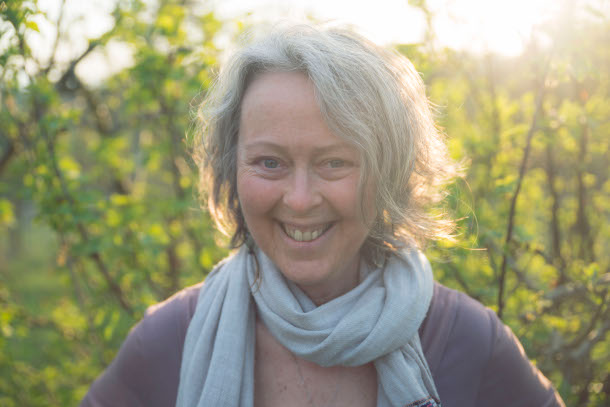
Brigit Strawbridge Howard is a bee advocate, wildlife gardener, naturalist, and author of the book Dancing with Bees: A Journey Back to Nature. (Photo: Courtesy of Chelsea Green Publishing)
BASCOMB: Brigit Strawbridge Howard is a bee advocate and author of the book Dancing With Bees: A Journey Back to Nature. Brigit, thank you so much for this delightful conversation.
HOWARD: No, thank you. It's my pleasure. Thank you, Bobby.
Links
Find out more about Dancing with Bees: A Journey Back to Nature on the Chelsea Green website
Living on Earth wants to hear from you!
Living on Earth
62 Calef Highway, Suite 212
Lee, NH 03861
Telephone: 617-287-4121
E-mail: comments@loe.org
Newsletter [Click here]
Donate to Living on Earth!
Living on Earth is an independent media program and relies entirely on contributions from listeners and institutions supporting public service. Please donate now to preserve an independent environmental voice.
NewsletterLiving on Earth offers a weekly delivery of the show's rundown to your mailbox. Sign up for our newsletter today!
 Sailors For The Sea: Be the change you want to sea.
Sailors For The Sea: Be the change you want to sea.
 The Grantham Foundation for the Protection of the Environment: Committed to protecting and improving the health of the global environment.
The Grantham Foundation for the Protection of the Environment: Committed to protecting and improving the health of the global environment.
 Contribute to Living on Earth and receive, as our gift to you, an archival print of one of Mark Seth Lender's extraordinary wildlife photographs. Follow the link to see Mark's current collection of photographs.
Contribute to Living on Earth and receive, as our gift to you, an archival print of one of Mark Seth Lender's extraordinary wildlife photographs. Follow the link to see Mark's current collection of photographs.
 Buy a signed copy of Mark Seth Lender's book Smeagull the Seagull & support Living on Earth
Buy a signed copy of Mark Seth Lender's book Smeagull the Seagull & support Living on Earth

